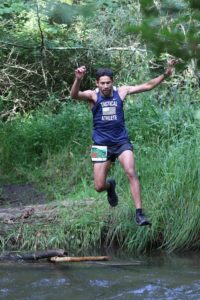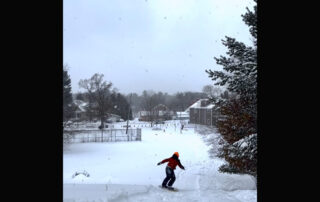Wisconsin’s Ice Age National Scenic Trail is a thousand mile footpath tracing Ice Age formations across the state. People are drawn to the trail for a bunch of reasons, and Janesville’s Stephen Strieker is introducing people to the trail through his love of running.

Runner Juan Moran at the Arbor Ridge Trail race creek crossing (Photo by David Sheen)
He was first exposed to the Ice Age Trail like a lot of people probably are.
“Just by chance, you know? Checking out parks in the area and then noticing the little yellow markers, and then one thing leads to the next,” he said.
But it was Strieker’s brother who got him to take his daily running from the road to the trail.
“He was doing endurance runs on the trail, and I’m like, ‘What is this? This sounds crazy,’” Strieker said.
He ended up participating in a bunch of trail races, including one on the shores of Lake Tahoe in California that he said hooked him for good.
Strieker eventually decided to host his own trail races on the Ice Age Trail near Janesville. He formed Arbor Rock Running, and donates profits to the Ice Age Trail Alliance.
“I was running with some friends, and we always would talk about [how] this would be a great place for a trail race. I just thought I’d give it a whirl,” Strieker said. “I really enjoy introducing people to the sport and connecting with people that share my interests.”
It’s that social component that seems to get Strieker most excited.
“You just meet so many different people from different facets of pulling off a race,” he said. “Everybody was just so supportive from the very beginning.”

Stephen Strieker and his daughter, Alison, at the Brooklyn Wildlife Area. (Photo by Sevie Kenyon)
And that’s where Dennis James comes in. He’s coordinator for the Rock County Chapter of the Ice Age Trail Alliance and has worked with Strieker on race planning.
James said the Ice Age Trail goes back to the 1950s. It was the vision of Milwaukee Lawyer Ray Zillmer, who loved the outdoors and wanted to highlight Wisconsin’s many unique glacial features.
The trail spans the state from the St. Croix River in the west to Door County in the east, and comes as far south as Janesville in Rock County, where there are 21 sustained miles of trail.
“We hope to add another 40 in the next decade or two,” James said.
And that’s the thing. The Ice Age Trail is still a work in progress. It takes a lot of volunteer hours to maintain and improve the trail.

Stephen Strieker congratulates a runner at the Robert O. Cook Memorial Arboretum outside Janesville, Wisconsin. (Photo by Andrea Paradowski)
“If I have one person for three hours and they can only give me three hours a year, that’s three hours I wouldn’t have had otherwise,” James said.
And Strieker agrees. He’s logged tons of hours on the trail to get it race-ready.
“The trails just don’t appear,” he said. “The have to be maintained, and the volunteers, those people are unbelievable.”
But he loves the work and it’s all worth it when the crowds show up on race day.
“That to me is a really important part of what I’m trying to do,” he said. “Getting people back out in to nature and their environment.”









